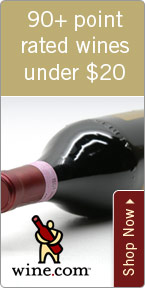Your Sommelier’s New Year Predictions

Wednesday - December 15, 2010
| Share
 Del.icio.us
Del.icio.usHere is my annual prediction list for the wine world in the new year. It’s always a very interesting exercise to try to foresee the future through a wineglass. It takes drinking a few glasses before I start getting these premonitions, but somebody has to do it.
1) Expect to see more new brands of wines made by well-known wine industry people. Because of the surplus of grapes on the bulk market in many areas of the world including the U.S., there has been a surge in the number of negociants. A negociant is someone who purchases already made wine or fruit, and bottles the wine under their own name brand. We already see quite a bit of this. Some famous sommeliers’ wines such as Rajaat Parr (Parr Selections) and Richard Betts (CC Wines) have already hit our market. They can be great values, but the difficulty is consistency. Because these labels purchase fruit from different lots and growers, they may not be the same year in and year out. The focus is definitely on value, and although the character of the wine may change, the value must still be there for these labels to remain popular and for us to drink them.
2) The 2009 vintage wines, which seems to be terrific throughout France, also will be the most expensive. The Bordeaux first growths have already made their first offerings of the 2009 vintage, which will not even be bottled and released until 2011. And they were not shy: $1,500 for a bottle, anyone? Only millionaires could drink those. I predict that other regions in France will follow suit. I’ve already heard rumblings from Burgundy and the Rhone on higher prices. The only caveat would be if the Euro collapses, in which case the dollar could reach parity, and the price increases would be absorbed into the exchange rate. The price increases will be felt obviously more on the high end and for wines that are made in smaller quantities. Francovinophiles, be forewarned.
3) The practice of biodynamics will become more popular and important in both wine production as well as wine selling. More wineries will start to implement biodynamic practices without advertising it and without using it as dogma. It will become more mainstream, but wineries will stay away from being pigeonholed as a “biodynamic” producer. These practices have shown significant differences in the health of vineyards as well as the quality in the resulting wines. Again I say that not all biodynamic wines are great. But the great winemakers who use it are seeing definitive improvements. In addition, more wineries and sales companies are scheduling important tastings and/or dinners on “Fruit” days (one of the four types of days in the bio-dynamic calendar) with the belief that the wines smell and taste their best on these types of days. I have seen the differences myself and can vouch for the noticeable difference a day makes.
4) Technology is moving faster every year. Some things will be better because of it and some things won’t. Less possibility for counterfeiters to reproduce the great wines of the world is good. Some wineries are creating custom packaging and tools in and on the bottle that cannot be replicated. I foresee the incidence of corked wines (TCA) to significantly decrease in newer wines. New technologies in closures and cleanliness will make it almost disappear. Oak flavoring is just around the corner, so producers will not need the wood, they will just be able to add the flavoring ingredient.
Recommendations: 2009 Crèmee dee Lyss Chardonnay ($10) Creamy, lush with fruit and a nice finish and texture. Excellent value! 2008 Bouchard Corton Charlemagne Grand Cru ($125) For the wine lover who has everything. This is real Grand Cru stuffed with minerals, great fruit and a finish that lasts and lasts.
Roberto Viernes is a master sommelier. E-mail .(JavaScript must be enabled to view this email address)E-mail this story | Print this page | Comments (0) | Archive | RSS Comments (0) |
Most Recent Comment(s):












